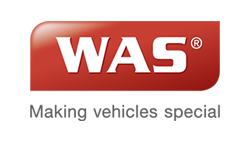

WAS, the manufacturer of special vehicles from Wietmarschen in Lower Saxony, is appearing at Rettmobil in Fulda with a new logo and a revised image A fresh trade fair stand with large numbers to catch the eye in addition to the vehicles being exhibited. Centred in the middle of the rear stand wall, a new logo stands resplendent with the slogan “Making vehicles special”. The two managing directors, Daniel Gotthardt and Andreas Ploeger, explain what it all means in an interview:
Gotthardt: In view of the ever-increasing trend towards internationalisation and the changes in healthcare, at the beginning of last year we began a complex process within the company: we wanted to position ourselves strategically as we move into the coming years and decades. We have done a lot of scrutinising and have set ourselves new objectives to achieve this. You can see the changes in our communication for first time at Rettmobil. We introduced them internally back in the fourth quarter of 2013.
Ploeger: With the new image, we want to permanently make WAS a brand which lives by traditional brand values and which is expressed in the vehicles and in the way we build vehicles. At the same time, we have defined what is important to us here in Wietmarschen and encapsulated our strengths: we make vehicles that are very special: Making vehicles special. Thanks to our expertise, our experience, the services we provide and much more. The history of our innovations shows that we don't stop thinking and that we provide an impetus in the industry, too.
Gotthardt: We wanted to be calmer and clearer in our overall corporate image. That's the basis for the new logo, too. Now we have a symbol that guarantees us maximum flexibility in everyday practical applications. At the same time, it is a symbol that will become a trademark for our work and our products: we produce special vehicles under the WAS brand. This position should also help us to win new target groups.
Gotthardt: We want to be identified as the manufacturer of special vehicles both at home and abroad. And not just associated with an application such as ambulances and fire engines. The in-house figures paint a clear picture: almost half of our production goes towards manufacturing very specialist vehicles for government authorities in various areas of responsibility, for fire brigades, disaster relief and for many other applications. The proportion of ambulance and emergency medical vehicles has been growing for years, but we are up against fierce competition on price. However, our primary goal is to tap new target markets to give the entire product range the benefits of the synergistic effects. Against this background, we must be identifiable as a competent manufacturer of special vehicles and position ourselves as such. We see still further potential for growth in this strategy.
Ploeger: Another aspect is of course our speciality, which we have been known for since the company began: we have more than 27 years of experience in developing and producing very specialist vehicles. As a special vehicle constructor, we started out as a manufacturer except that the term wasn't used to mean the same thing back then. Today, every vehicle is still produced by hand in our factory. Even series-produced vehicles. Our approach and our way of thinking is always “1st edition”. If customers wish – as they do relatively frequently – we can produce a second, a third or 100 vehicles in the same design. For WAS, “1st edition” and series production are not contradictions. On the contrary: that is our major advantage!
Gotthardt: The numbers are eye-catching and are designed to get our visitors talking. Every number has a story associated with it, which tells you facts about the WAS company. For example, the number of employees in our company headquarters in Wietmarschen. Or that we carried out more than 2000 maintenance jobs on ambulances and their technical equipment in 2013 alone. Or that our box body vehicles are among the lightest on German roads, with a total weight of 4.6 tons. Rettmobil 2014 is the place where we want to impress our existing customers and new customers with facts, but also surprise them.
Ploeger: We have looked at the issue of stress for paramedics and patients and developed solutions which we are showcasing for the first time at Rettmobil. It is well-known that patients are exposed to several stress factors inside an ambulance: one factor is transferring the patient to the inside of the ambulance, which is determined by the way the paramedic handles the wheeled stretcher and by the way it is fastened to the ambulance table. To take the stress away from the paramedics, we have developed an entry assistance system which pulls any wheeled stretcher from established manufacturers onto the ambulance table gently and smoothly. The ambulance crew therefore no longer have to push the stretcher onto the ambulance table. Using soft control, the stretcher is gently pulled into the ambulance and secured, making it a stress-free experience for the patient. The system is called WAS Multi-Load Assist. Another innovation is the electromechanical power closing for all the doors in a WAS box body. WAS Door Assist pulls the doors into the seals quietly and without generating any vibrations. The days of slamming the doors shut are long gone. That is another example of making the patient compartment a more stress-free zone.





